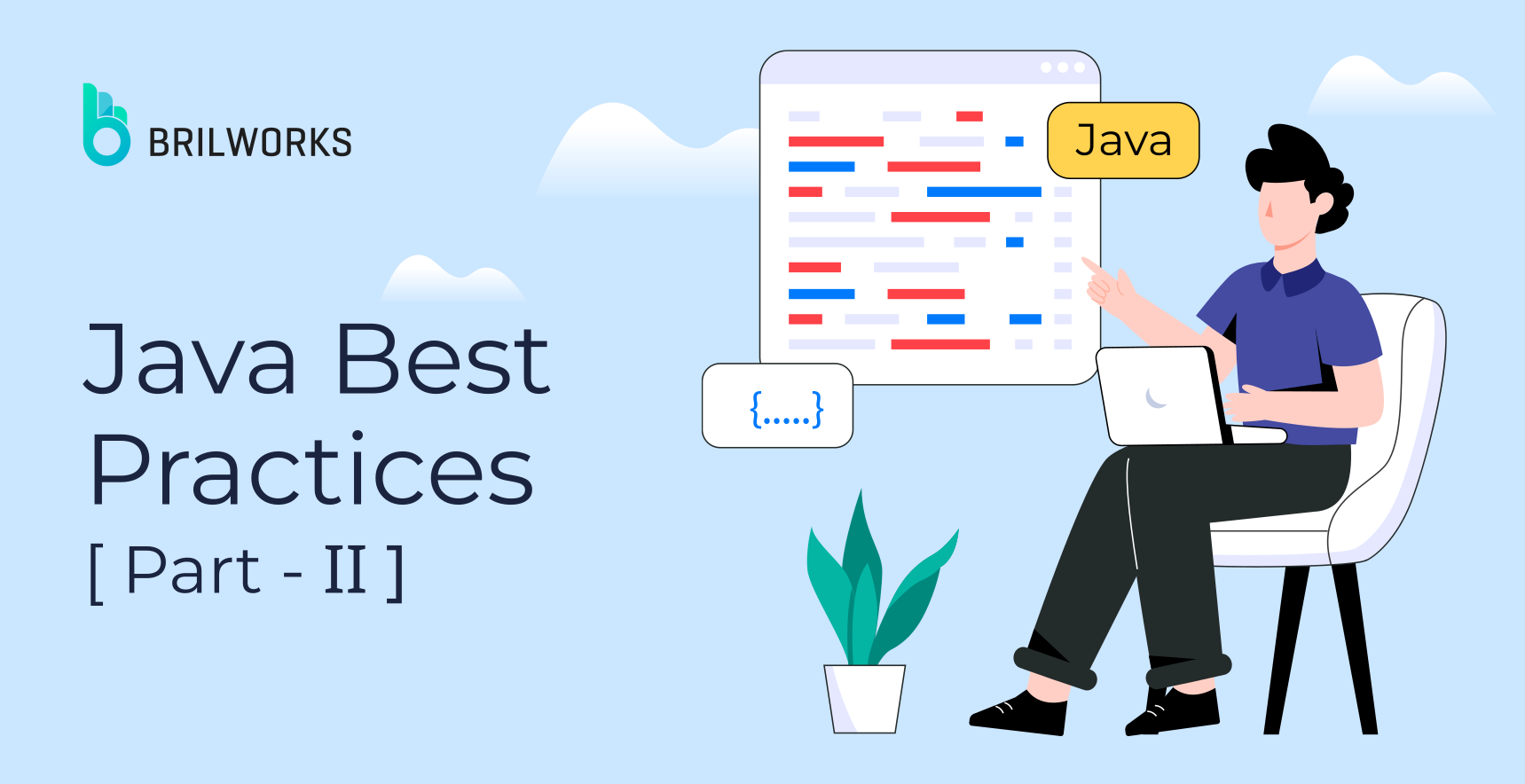COOPERATION MODEL
ARTIFICIAL INTELLIGENCE
PRODUCT ENGINEERING
DevOps & Cloud
LOW-CODE/NO-CODE DEVELOPMENT
INDUSTRY
FRONTEND DEVELOPMENT
CLOUD DEVELOPMENT
MOBILE APP DEVELOPMENT
LOW CODE/ NO CODE DEVELOPMENT
EMERGING TECHNOLOGIES








Welcome back to our blog on Java best practices. In our previous post, we talked about the practices of writing clean code and described what are the benefits of employing these practices. If you missed our last article, you can read it here.
Clean code is the practice of writing code that is easy to read, understand, and maintain. When your code is well-organized and follows established standards, it communicates its intent clearly without the need for extensive explanations. Clean code offers numerous benefits, as mentioned below.
Let's dive right into the second part of our Java best practices journey. In this part, we will be exploring some more methods that will level up your Java coding game.
Avoid unnecessary assignments to variables, as Java automatically initializes primitive types and reference types with default values when they are declared as class or interface fields. For instance:
Hence, it's advisable to avoid explicitly initializing these fields to their default values, as it becomes redundant and unnecessary. Consider the following examples:
// Bad Practice: Redundant Initialization
public class Employee {
// Redundant initialization
private String name = null;
private int age = 0;
private boolean active = false;
}
// Good Practice: No Initialization Needed
public class Employee {
// No initialization needed
private String name;
private int age;
private boolean active;
}The redundant initialization adds extra code without changing the class's behavior or state. In contrast, the good practice of omitting the initialization makes the code more concise and clear.
Keep in mind that this rule applies only to “fields” of a “class” or an “interface.” Local variables declared within a method or block must be explicitly initialized before use to avoid compile-time errors.
Mutability refers to the ability of an object or data to be changed after its creation. While it has its advantages, it also introduces challenges, such as difficult to debug program. Therefore, it's important to use mutability carefully and consider the trade-offs between mutability and immutability based on the specific requirements of your program.
Immutability is a powerful technique that helps reduce bugs caused by unexpected changes. Hence, it is good practice to minimize mutability in classes and variables. You can use the "final" keyword for constants and variables that should remain unchanged.
final int MAX_ATTEMPTS = 3;
final String API_KEY = "abc123";No Empty Catch Blocks: When you are programming, exceptions, or unexpected events, are inevitable. There are various methods exist to deal with unexpected events. An empty block in Java is used for error handling, but it allows the program to continue running without throwing an error.
This means that when an exception is thrown in the try block, the catch block simply catches the exception and does nothing else. Therefore, you should avoid using empty catch blocks, which can lead to the silent failure of the program.
In this example, catch block is empty, and when we run this method with the following parameter [“123”, “1abc”]
The method will fail without any feedback. It will return 123, even though there was an error. This is because the exception is ignored. It's important to handle exceptions so that we know when something goes wrong. Ignoring exceptions can lead to silent failures, which can be difficult to debug further.
Always handle exceptions appropriately to prevent unexpected crashes and ensure graceful error recovery. Use specific exception types rather than catching generic Exception classes. For instance:
Consider the following code snippet:
public int aggregateIntegerStringss(String[] integers) {
int sum = 0;
try {
for (String integer : integers) {
sum += Integer.parseInt(integer);
}
} catch (NumberFormatException ex) {
}
return sum;
}In this example, catch block is empty, and when we run this method with the following parameter [“123”, “1abc”]
The method will fail without any feedback. It will return 123, even though there was an error. This is because the exception is ignored. It's important to handle exceptions so that we know when something goes wrong. Ignoring exceptions can lead to silent failures, which can be difficult to debug further.
Always handle exceptions appropriately to prevent unexpected crashes and ensure graceful error recovery. Use specific exception types rather than catching generic Exception classes. For instance:
// Avoid
try {
// Risky code
} catch (Exception e) {
// Exception handling
}
// Prefer
try {
// Risky code
} catch (IOException e) {
// IOException handling
}Minimize the number of I/O operations and use buffered streams or readers/writers for efficient reading and writing of data.
// Avoid
FileInputStream fis = new FileInputStream("myfile.txt");
int data;
while ((data = fis.read()) != -1) {
// Process data
}
fis.close();
// Prefer
BufferedInputStream bis = new BufferedInputStream(new FileInputStream("myfile.txt"));
int data;
while ((data = bis.read()) != -1) {
// Process data
}
bis.close();List<Integer> numbers = Arrays.asList(1, 2, 3, 4, 5, 6, 7, 8, 9, 10);
int sum = numbers.parallelStream().mapToInt(Integer::intValue).sum();// Bad Practice
user.getRole().equals(UserRole.ADMIN);
// Good Practice
UserRole.ADMIN.equals(user.getRole());The following code can be improved:
if(user.isAdmin){
// execute code
} else {
throw error
}
Like this:
if(!user.isAdmin){
throw error
}
//execute code// Bad Practice
public class LongMethod {
public void complexTask() {
// A lot of steps here
}
}
Break down long methods into smaller ones.
// Good Practice
public class MethodBreakdown {
public void firstStep() {
// First step logic
}
public void secondStep() {
// Second step logic
}
// ...
}// Bad Practice
@RestController
public class MainController {
@GetMapping("/api/items")
public List<Item> getItemsAndPerformOtherTasks() {
// Multiple tasks done here
}
}
Divide responsibilities between controllers.
// Good Practice
@RestController
@RequestMapping("/api")
public class ItemController {
@GetMapping("/items")
public List<Item> getItems() {
// items logic
}
}
@RestController
@RequestMapping("/api")
public class TaskController {
@GetMapping("/tasks")
public List<Task> getTasks() {
// tasks logic
}
}Proper code formatting is one of the key aspects of writing clean code. Consistent formatting promotes better readability of the codebase. Regarding formatting, indentation, blank lines, and line length are crucial aspects of code formatting. The proper indentation, character limit and separate blocks make the codebase pleasant to read.
Code organization in Java, or any other programming language, is all about how you arrange your code to make it easier to work with. Bringing your source code neatly makes it much more maintainable and can grow without becoming a big mess.
One way to do this is by using packages. They act like folders for your code, grouping related stuff together. So you can find things quickly when you need them.
Good code organization is super important because it saves time and effort when you want to make changes or add new features. Plus, it helps other developers understand your code better, which is a big win for teamwork!
Tips:
Writing test code is crucial because it helps make sure our code works the way we want it to. It's like a safety net that catches any mistakes we might make. We can test if our functions and methods give the right results for different inputs. Also, testing is a great way to catch bugs early on.
Instead of comprehensive testing, you can focus on testing individual units (classes, methods, functions). Testing individual units ensures code behaves as expected, making it easier to identify regressions and maintain code integrity. Write tests early in the development process.
public class MathUtilsTest {
@Test
public void testAddition() {
int result = MathUtils.add(2, 3);
assertEquals(5, result);
}
}Below are some popular tools that you can use to test your Java code.
In addition to this, Mockito, PowerMock, Selenium, and various other tools for different kinds of testing. Remember, testing is what sets professional developers apart from immature ones.
Code review is a critical aspect of every programming language. It's like having experienced developers inspect your code to make sure it's well-structured and follows the rules and conventions. Code review can be done by peers, senior developers, or external experts. They focus on readability, maintainability, and if the code meets coding standards. They can even suggest ways to optimize your code.
It is an essential step to ensure the structure of your codebase. It's like having a second set of eyes spot any issues. It's all about making your code shine and become the best it can be.
If you want to review your own code, here are some tips:
Code Review Checklist
1. Code style and conventions:
2. Error handling:
3. Security:
4. Performance:
5. Maintainability:
6. Testing:
It's essential to include REST API standards as they have an important role in software development. RESTful APIs (Representational State Transfer) serve as a crucial means of communication between different systems. By following REST API standards, you can create a clean and easily understandable codebase.
1. Use HTTP methods correctly
2. Use clear and consistent URI structure
3. Use HTTP status codes correctly:
4. Use JSON format for data exchange
5. Use pagination for large collections
6. Implement security measures
7. Write documentation
Practicing clean code is essential, and avoiding it can lead to an unmanageable codebase. Additionally, debugging can become challenging if the code doesn't adhere to the standards set by developers. In this series of two blogs, we have compiled a list of best practices for Java developers to follow. We hope you find this article useful and informative.
This blog, “Java Best Practices,” serves as a comprehensive guide to mastering the art of writing human-readable, clean, and well-optimized Java code. By following these practices, you can elevate your skills and write code that is not only easy to read but also adheres to standardized conventions.
If you have an existing project in need of a Java application overhaul or enhancement, please don't hesitate to get in touch with us. We have the expertise and resources to assist you in revitalizing your application. So, why wait any longer? Take action now—hire a Java developer today and embark on a journey to transform your application into something extraordinary.
What are the best practices while coding in Java?
When coding in Java, prioritize clear communication and maintainability through consistent naming conventions, private class members, and comments. Optimize performance by using StringBuilder, enhanced loops, and avoiding unnecessary object creation. Ensure code health with proper exception handling, null checks, and memory leak prevention.
What is the best way to code in Java?
While there's no single "best" way, effective Java coding emphasizes clarity and maintainability. Start by fully understanding the problem, plan your code structure, and keep it simple. Use meaningful names for variables and functions, comment strategically, and follow consistent formatting. Regularly test and refactor your code for efficiency and readability. Embrace online resources, tutorials, and best practices to elevate your skills.
What are the benefits of writing clean code in Java?
Writing clean Java code offers several benefits. By adopting these practices, you create code that is easy to understand, modify, and extend. This leads to faster development, fewer bugs, and smoother collaboration.
Get In Touch
Contact us for your software development requirements
Get In Touch
Contact us for your software development requirements